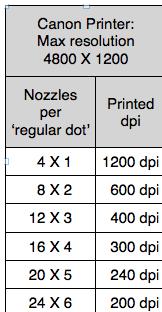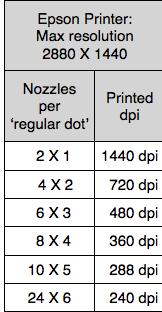|
|
|
Frequently asked questionsImage to print: DPI, ppi, and pixels. How do they fit together? (continued)Print head construction and printer resolutionPeople making photographic prints are often advised to print at 300 dpi, or 360dpi or some other apparently magic number. Why, when we know that 250 dots per inch should be good enough? Print heads are made with very tiny nozzles that squirt ink to the paper. They are, generally, very much smaller than 1/250”. For example, my Canon Pro 9000 printer’s print head has a maximum resolution of 4800 dpi X 1200 dpi. My Epson 3880 printer has a maximum resolution of 2880 x 1440 dpi. These resolutions are much finer than 250 dpi so why don’t we just print at 1200 dpi, or 1440 dpi? To do that means sending an individual piece of data to every nozzle on the print head. That, in turn, means very large image data files, slower processing, and therefore slower print speeds. All for a dot size so small it would make no difference. In real printers, then, nozzles are bunched together and the printer driver sends the same data to all the nozzles in a bunch, to make 1 dot. The question is, how many nozzles can you bunch to make dots that are still so small as to be imperceptible, but as big as possible to be optimal from a data and processing Consider my Canon Pro 9000 printer. For practical purposes its print head is capable of a 1200 nozzle-squirts per inch resolution. (The vertical resolution is the practical limit of resolution because the dots should be as wide as they are high.) We can make our dots by bunching these nozzles in 4X1, 8X2, 12X3, etc. The table shows dot size (in nozzle-squirts) for the Canon printer. I could print on the Canon at 240 dpi and be reasonably confident that only people with 20/20 vision could see the individual dots. Most people advise 300 dpi for the Canon to be sure.
I could print on the 3880 at 240 or 288 dpi and be reasonably confident that most people could not see the individual dots. Most people advise 360 dpi for the Epson to be sure. (Jeff Schewe reported an interesting test of these numbers here.) The tables also show why the printer driver will resample an image if it is sent to the printer with any other numbers. The printer can only print a dot using whole numbers of nozzles so any proposed numbers of dots per inch will be resampled to the nearest whole numbers as in the tables. More on this here. In most photo-printing software you can specify the number of dpi that you want for your print. But what will go into those dots? Image PrintingThe most straight-forward and accurate print is one where each pixel in the image is sent to an exactly corresponding ‘dot’ on the print. If I were printing a 3000 pixel X 2000 pixel image on my Pro 9000 printer, at a print resolution of 300 dpi, my print size would be 10” X 6.7” (why? ) If I want to print an enlargement, and if I want to retain the simplicity of 1 pixel ➝ 1 print dot, I have to choose a lower dot pitch. For example, if I print at 240 dpi, my print size would be 12.5” X 8.3”. Of course now I risk that the dots are visible unless I can be sure the viewers never look more closely than from about 30”. On the other hand, if I can hold my viewers back to a distance of 20m (about 720”), then I could afford to print at about 4.5 dpi, and my 3000 X 2000 pixel image could be made into a billboard about 16m X 10m. All that with a 6MP camera! Resampling In practice, most printing cannot be done with a straightforward 1 pixel -> 1 dot transformation using our original image. In almost every case, we need to scale our image to suit a paper size, or intended display size, such as for a photographic competition or exhibition. Remembering that ink-jet printers print at specific dot-per-inch ratios, such as 240 dpi, 300 dpi, 360 dpi etc, depending on the makeup of their print head, the objective is to try and reconstruct our image file to output a 1:1 pixel-to-dot match for the desired dot pitch and print size. |
|

 perspective?
perspective? The effective resolution of my SP 3880 is 1440 nozzle-squirts per inch. The table shows the nozzle arrangements possible for the Epson.
The effective resolution of my SP 3880 is 1440 nozzle-squirts per inch. The table shows the nozzle arrangements possible for the Epson.